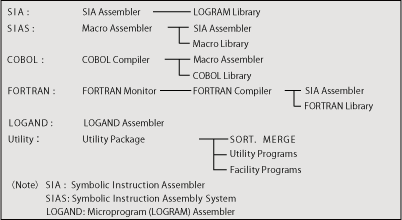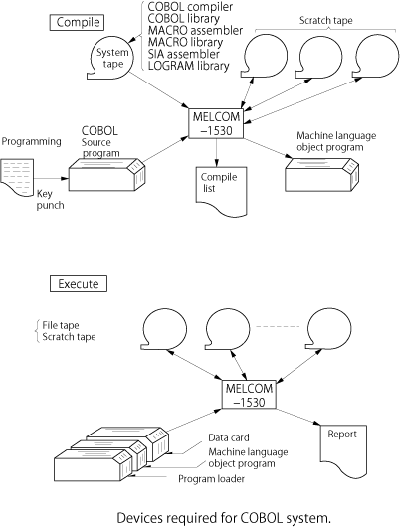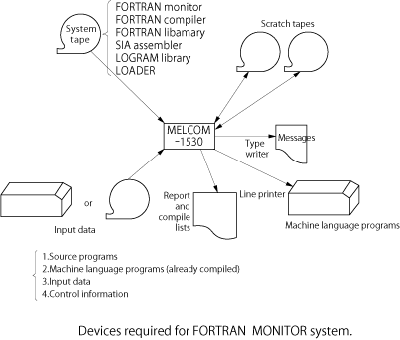Mitsubishi Electric’s MELCOM-1530 system announced in 1963 was a computer that adopted an innovative method called “stored logic,” which pioneered microprogrammed control. To easily and efficiently create and test its program, system programs organized as follows were developed:

- Home >
- Historical Computers in Japan >
- Mainframe OS >
- System Programs for MELCOM-1530
【Mitsubishi Electric】 System Programs for MELCOM-1530

SIA and SIAS assemblers and FORTRAN and COBOL compilers were provided.
- (1) SIA
- SIA had not only a standard assembler function of converting into an object program a program created using symbols that responded to the machine instructions of the computer, but also a function to add to the object program a microprogram (called LOGRAM) that corresponded to the machine instructions used in the created program by selecting them from a LOGRAM Library. In the execution stage, LOADER loaded the object program and LOGRAM onto the core memory.
LOGRAM can also be created using the LOGAND Assembler. - (2) SIAS
- SIAS was based on SIA and had a macroinstruction function. When a macroinstruction was assembled, an instruction for calling a corresponding subroutine written in SIA was generated and the subroutine was selected from a macro library and added to the object program.
The macroinstructions were mainly I/O instructions with a magnetic tape in business data processing, and four instructions of OPEN, CLOSE, GET and PUT were provided for each of the 4 access modes (a) to (d) as shown below: - (a) Tape without label, fixed-length record
- (b) Tape with label or tape without label, fixed-length record
- (c) Tape with label or tape without label, variable-length record
- (d) Tape with label or tape without label, variable-length record, with buffering function
- (3) FORTRAN
- The system programs adopted FORTRAN IV, which was newly defined at that time.
- (4) COBOL
- COBOL was compliant with COBOL 61, which was most commonly used at that time, and adopted all of Required COBOL and part of Elective COBOL of COBOL 61. MELCOM-1530 realized an efficient system by defining a machine language that matched the processing with COBOL while taking advantage of the stored logic (microprogramming). The following figure shows an example of processing using COBOL:

2. Utilities
The utilities included SORT, MERGE, Card to Tape, Tape to Print, Card to Print and Tape to Card.
The utilities included SORT, MERGE, Card to Tape, Tape to Print, Card to Print and Tape to Card.
3. Test support (Facility Programs)
The programs for testing programs included CAP (Control and Analysis Program), ITDD (Interpretive Trace and Dynamic Dump), TRACE (Trace Program) and Tape Dump.
CAP was used for static debugging, which was a method for checking the content of the core memory by dumping it while the program stooped, and ITDD was used for dynamic debugging, whose purpose was to print the content of intermediate states of core memory or accumulators while the program was running.
The programs for testing programs included CAP (Control and Analysis Program), ITDD (Interpretive Trace and Dynamic Dump), TRACE (Trace Program) and Tape Dump.
CAP was used for static debugging, which was a method for checking the content of the core memory by dumping it while the program stooped, and ITDD was used for dynamic debugging, whose purpose was to print the content of intermediate states of core memory or accumulators while the program was running.
4. Support for computer operation
For program operation and preparation, FORTRAN monitor and Tape Operating System were provided in addition to CAP and LOADER.
For program operation and preparation, FORTRAN monitor and Tape Operating System were provided in addition to CAP and LOADER.
- (1) FORTRAN monitor
- FORTRAN monitor was a program that successively processed a program written in FORTRAN from compiling it to a machine language to executing it. Therefore, as indicated in the figure below, a FORTRAN compiler, a FORTRAN library, an SIA assembler, a LOGRAM library and LOADER were integrated into a single tape. There were three types of inputs to the FORTRAN monitor: (a) to (c) as shown below. And, the monitor enabled the continuous process of these inputs by collecting them into an input tape.
- (a) FORTRAN program (compiling only)
- (b) Object programs from FORTRAN, COBOL, SIA and SIAS, and data to be processed with those object programs.
- (c) FORTRAN program, and data to be processed with that program.

- (2) Tape Operating System
- The Tape Operating System was designed to continuously process programs used especially for business data processing, through a single system tape that stored system programs including SIA, SIAS, FORTRAN, COBOL, SORT, MERGE and other utility programs, and the object programs of the processing programs created by the users. It selected a program designated by the operator, loaded it onto the core memory, and executed it.
All Rights Reserved, Copyright (C) Information Processing Society of Japan
